The rent growth fever may have just broken. For the first time in six years, year-over-year rent growth is flat.
According to a new report from Zillow, the national median rent in August came in at $1,440, unchanged from a year ago. This is the sixth consecutive month of slowing rent growth and month 27 of sub-3% annual growth.
Out of the 35 largest U.S. markets, the median rent fell on an annual basis in 19 of them in August.
Concurrently, a slowdown of home price appreciation brought the rate of appreciation to its slowest pace in two years. Nationally, home values rose 6.5% YoY, which could mean that down payments became a little more attainable for would-be homebuyers, allowing them to purchase and reducing some of the upward pressure on rents from pent-up demand for multifamily product.
Additionally, the severity of the lack of homes for sale is lessening. This year there were only 3.6% fewer homes for sale than last year, whereas last year the number of homes for sale had fallen 13.1% YoY.
Add these together and it appears that, this year, relief is coming from changes in the single-family home market fundamentals instead of a marked change in the multifamily market.
"Earlier this year, the housing market was a story of diverging paths, with rents steadily cooling and home values picking up speed. Normally rents and home values are tied together, but strong apartment construction and a surge of young homebuyers contributed to this historical anomaly. As summer turns to fall, the more typical pattern is reemerging, as rents and home values are both slowing in unison," Zillow Senior Economist Aaron Terrazas said in a statement.
"The feverish housing crunch of the past few years seems to be cracking. Slower rent growth means that renters may feel less urgency to buy. While home values continue to grow at double their historic pace, the speed of appreciation is down sharply from its spring highs," he added.
As it stands, 31.7% of all Americans qualify as burdened by housing costs (spending 30% or more of their incomes on housing), and of that number, 15% are severely burdened (spending 50% of their incomes on housing).
The biggest contributor to the cost burden of housing has been the lack of available housing, both single-family and multifamily, and much of that lack can be attributed to rising construction and compliance costs.
There are efforts being made at multiple levels to deal with the issues, but they are firmly entrenched and will require major effort or a favorable change in the economics to take the pressure of Americans in need of affordable housing.
Though far from relieving the housing affordability blues the nation is suffering through, this is a ray of hope for a free-market solution to the affordability issue.
If the market is moving toward equilibrium on its own and continues on this path, the need for government intervention may lessen.




